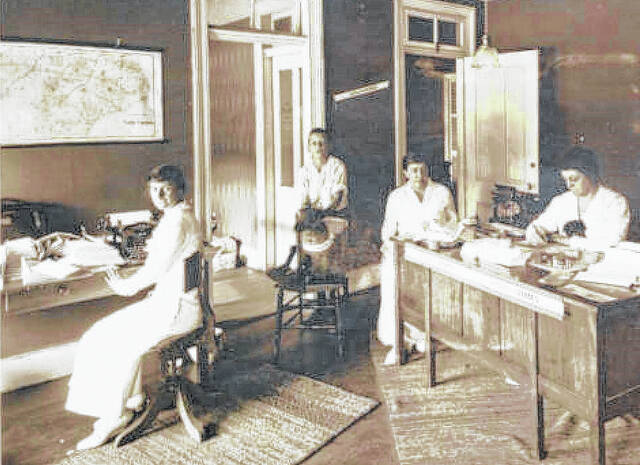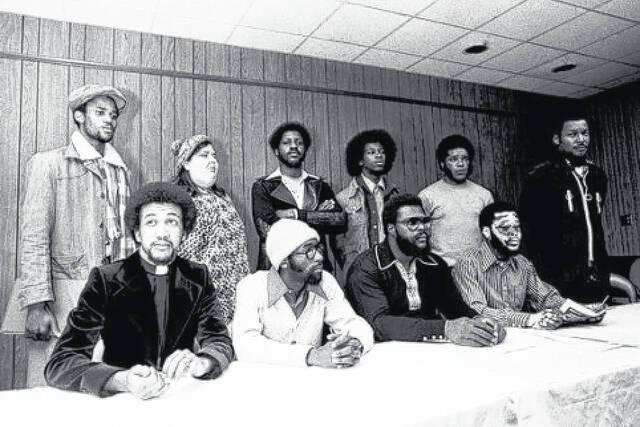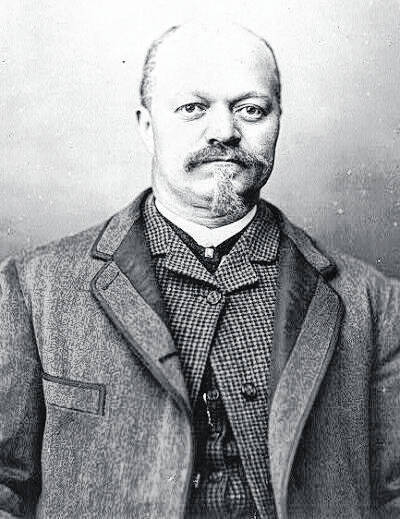
Image from Office at the N.C. Equal Suffrage Association headquarters in Raleigh, ca. 1910s. L-R: Gertrude Weil; Palmer Jerman (a page) with dog; Sallie Dortch, volunteer chair; Cornelia Petty Jerman, chair of the state ratification committee. A “Votes for Women” grosgrain ribbon is tacked to the desk.
Gertrude Weil Papers, PC.1488.50, folder 4 | N.C. State Archives
THIS WEEK IN HISTORY
This Week in North Carolina History
Feb. 3: First African-American on the N.C. Supreme Court. On Feb. 3, 1983, Henry Frye was sworn in as North Carolina’s first African-American Supreme Court Justice. Governor Jim Hunt appointed Frye as an associate justice. Then, in 1999, in another first, Hunt named Frye to the unexpired term of retiring Chief Justice Burley Mitchell. After Frye lost his bid for a full term as chief justice in 2000, he retired, having served on the state’s top tribunal for more than 17 years.
Frye has led a remarkable life. Born the son of a Richmond County farmer in August 1932, he graduated with top honors from North Carolina A&T State University and became a U.S. Air Force captain. Despite his education and service, he was told he had failed the required literacy test when he returned home and attempted to register to vote in 1956. The experience inspired him to become a lawyer.
In 1968, Frye became the first African American elected to the North Carolina General Assembly in the twentieth century. The first bill he introduced was a constitutional amendment abolishing the literacy test. Frye eventually served six terms in the state House and one term in the state senate before he began his judicial career.
Feb. 4: Clubwoman and Suffrage Leader Cornelia Jerman. On Feb. 4, 1946, women’s suffrage leader Cornelia Petty Jerman died. At the time of her death, the Raleigh News & Observer called her the “State’s First Woman.”
Born in Moore County near Carthage, Jerman moved to Raleigh shortly after her marriage in 1898. She became active in the city’s social life, and was very involved with the Woman’s Club of Raleigh and state and national organizations of women’s clubs.
Jerman’s social involvement soon became political. She helped organize the Raleigh Equal Suffrage League, served as president of the North Carolina Suffrage League and lobbied the General Assembly extensively for women’s right to vote and other causes. She also helped organize, and served as president of, the Raleigh League of Women Voters.
Becoming active in Democratic Party politics after 1920, Jerman campaigned for Al Smith and Franklin D. Roosevelt in 1928 and 1932, respectively, and was appointed to a position with the Internal Revenue Service in Greensboro.
She worked in a number of other capacities before her death in 1946.
Feb. 6: The Wilmington 10 and Firebombing of Mike’s Grocery: On Feb. 6, 1971, Mike’s Grocery, a mom-and-pop store in Wilmington, was firebombed and burned. It’s unclear who was responsible for the arson, which came after a week of increasing racial tension and violence over the desegregation of the city’s high schools.
Demanding fairer treatment and a black studies curriculum, black high school students, led by civil rights activist Ben Chavis, began a boycott of classes in late January 1971. The protesters established headquarters at a local church, which became the epicenter of violence after the school board rejected their demands. A racist organization attacked the church in drive-by shootings, and gunfire and arson ensued in the area. Police killed a student protester, and a white supremacist was killed as he took aim at the church.
About a year later local and state authorities, intent on punishing Chavis, arrested him, eight black high school students and a white anti-poverty worker on charges related to the arson at Mike’s.
Despite the lack of real evidence tying them to the arson, the prosecutor secured guilty verdicts by using perjured testimony and illegally excluding blacks from the jury. The case garnered national press attention, and in 1976, Amnesty International became involved in an effort to free the Wilmington 10.
Key witnesses recanted their testimony in the late 1970s and investigatory pieces by 60 Minutes, the New York Times and others suggested evidence had been fabricated. The Soviet Union even cited the Wilmington 10 as an example of American political imprisonment when Pres. Jimmy Carter criticized that country for the practice in 1978.
The convictions of the Wilmington 10 were ultimately overturned by the U.S. Court of Appeals for the Fourth Circuit in 1980. Governor Beverly Perdue issued them pardons in 2012.
Feb. 6: Swain County’s “Road to Nowhere.” On Feb. 6, 2010, Swain County’s six-mile “Road to Nowhere” was officially abandoned by the federal government.
The road—called Lakeview Drive—dates back to the 1940s when the federal government and the Tennessee Valley Authority took over land in Swain and Graham Counties and flooded it as part of the Fontana Dam and Great Smoky Mountains National Park projects. The government promised it would build a 30-mile road to help make up for the loss of access to the area caused by the closure of Highway 288, which was flooded. Shortly after construction began, the project stalled due to environmental issues. Although funding for the work was appropriated later, the road never came to fruition largely because the cost of its construction was so high.
In February 2010, the National Park Service aggreed to pay Swain County $52 million—the approximate cost of fulfilling the government’s promise—as a substitute to actually finishing the drive. To this day, Lakeview Drive provides some of the best views of Fontana Lake, the Tuckasegee River and the surrounding landscape.
Feb. 6: Long Route to Roanoke River Lighthouse. On Feb. 6, 1832, Elizabeth City congressman William Shepard petitioned the House of Representatives for a light station to help guide sailors to safety by the mouth of the Roanoke River.
Two years later, Congress appropriated $10,000 for a lightship to operate on the Albemarle Sound. The ship operated through the Civil War, but was replaced by a screw-pile lighthouse that operated on whale oil in 1867. That structure, in turn, was damaged by fire and ice in the 1880s.
A larger lighthouse, the one that currently stands, was authorized in 1886 and finished by 1887. It was fitted with a Fresnel lens and continued to operate until 1941, when it was decommissioned by the Coast Guard.
The 1886 Roanoke River Lighthouse changed hands twice in the 1950s, sold for $10 each time. Edenton businessman Emmett Wiggins moved the structure to land he owned in the Chowan County town in 1955, and he lived in the building until his death.
In 2007, the Edenton Historical Commission purchased the lighthouse and restored it in cooperation with the state of North Carolina. The restored lighthouse opened to the public as part of Historic Edenton State Historic Site in 2012.
Feb. 8: The Coleman Manufacturing Company, Landmark African American Business. On Feb. 8, 1898, Warren Coleman and his associates laid the cornerstone for the nation’s first black-owned cotton mill in Concord.
Congressman George H. White, himself a civil rights pioneer, was the main speaker at the event. The company represented the first major cooperative effort by North Carolina’s African American businessmen.
Coleman was the son of Rufus Barringer, a Confederate general, and Roxanna Coleman, a slave. From meager beginnings, he rose to become the wealthiest black man in the state by the 1890s after starting a combination barber shop and candy store and parlaying his success with that enterprise into a large real estate and mercantile business.
With his statewide contacts and a belief in the self-help philosophy of Booker T. Washington, Coleman assembled partners from the state’s “black elite” to start the mill. James Walker Hood, John C. Dancy and Edward A. Johnson were among the men he asked to join him in the project. The company also had white backers including tobacco magnates Julian Carr and Benjamin Duke.
At its peak, the mill employed 300 black workers. Industry-wide economic troubles forced Coleman to resign from the company in December 1903, and Benjamin Duke foreclosed on the mortgage the next year.
Later a section of the mill built by Coleman was operated as a subsidiary of Cannon Mills Company, headquartered in nearby Kannapolis.
Feb. 9: At Point Guard, From Rocky Mount, Phil Ford. On Feb. 9, 1956, basketball legend Phil Ford was born in Kannapolis.
Ford was raised in Rocky Mount, where he graduated from high school in 1974.
As a point guard at UNC-Chapel Hill, he led the basketball team to four NCAA tournaments. Ford’s accolades during his college career were many. In 1978, he capped off his senior year by winning the coveted John R. Wooden Award, given annually to the country’s most outstanding college basketball player.
He graduated that year with a degree in business administration.
Ford was the number two pick in the 1978 NBA draft, going to the Kansas City Kings. The following year, he was named NBA rookie of the year. During the course of his career, Ford also played professionally for the New Jersey Nets, the Milwaukee Bucks and the Houston Rockets.
Inducted into the North Carolina Sports Hall of Fame in 1991, Ford now works for the fundraising arm of UNC’s athletic department.
This Week In Nation And World History
Feb. 2, ‘American Sniper’ Chris Kyle killed. On Feb. 2, 2013, former Navy SEAL and “American Sniper” author Chris Kyle was fatally shot along with a friend, Chad Littlefield, at a gun range west of Glen Rose, Texas; suspect Eddie Ray Routh was later convicted and sentenced to life in prison without parole.
Feb. 3: 16th Amendment to the U.S. Constitution was ratified. On Feb. 3, 1913, the 16th Amendment to the U.S. Constitution, providing for a federal income tax, was ratified.
Feb. 4: Revolutionary War ends. On Feb. 4, 1783, Britain’s King George III proclaimed a formal cessation of hostilities in the American Revolutionary War.
Feb. 5: Senate acquits Donald Trump in first impeachment. On Feb. 5, 2020, the Senate voted to acquit President Donald Trump, bringing to a close the third presidential trial in American history, though a majority of senators expressed unease with Trump’s pressure campaign on Ukraine that resulted in the two articles of impeachment. Just one Republican, Mitt Romney of Utah, broke with the GOP and voted to convict.
Feb. 6, Queen Elizabeth II takes throne after death of father King George VI. On Feb. 6, 1952, Britain’s King George VI, 56, died at Sandringham House in Norfolk, England; he was succeeded as monarch by his 25-year-old elder daughter, who became Queen Elizabeth II.
Feb. 7, Cuba Embargo. On Feb. 7, 1962, President John F. Kennedy imposed a full trade embargo on Cuba. And in 1964, the Beatles arrived to screaming fans at New York’s John F. Kennedy International Airport to begin their first American tour.
Feb. 8, Queen beheaded. On Feb. 8, 1587, Mary, Queen of Scots was beheaded at Fotheringhay Castle in England after she was implicated in a plot to murder her cousin, Queen Elizabeth I.
Feb. 9, Big quake in California. On Feb. 9, 1971, a magnitude 6.6 earthquake in California’s San Fernando Valley claimed 65 lives. The crew of Apollo 14 returned to Earth after man’s third landing on the moon.
Source: NC Department of Natural and Cultural Resources
Executive Editor David Kennard compiles the History column from Robesonian archives, the North Carolina Department of Natural and Cultural Resources and Associated Press reports.











